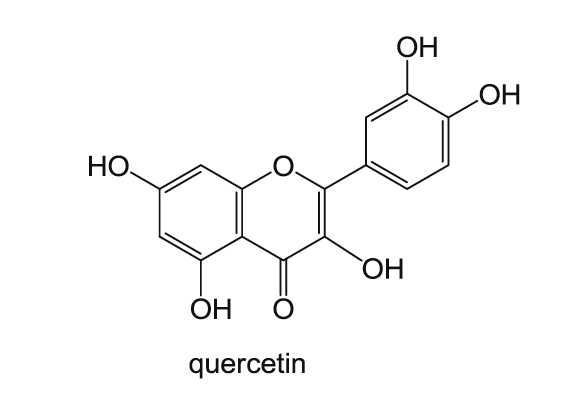
The vibrant colors we observe in plants serve a different role depending on the organism being considered. For the plant itself, the pigments may aid in the absorption of light and photosynthesis, as well as contribute to metabolism and reproduction. For birds and insects, the pigments provide a signal to the availability of food, such as nectar or pollen. For humans, the pigments may provide a clue of the type of health benefits we are likely to incur upon ingestion.
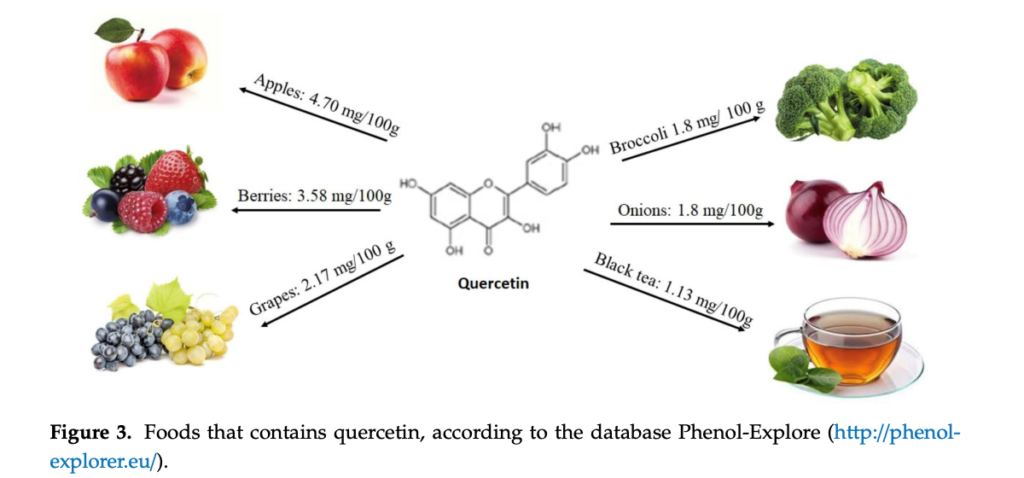
Quercetin is a yellowish pigment that belongs to a group of plant compounds called flavonoids. As the most abundant flavonoid in the diet, quercetin is found in apples, onions, grapes, berries, broccoli, eucalyptus, tea and blue-green algae. In addition to its potent antioxidant qualities, quercetin is useful in prevention and treatment of allergic reactions, cancer, heart disease and inflammatory conditions such as psoriasis and urticaria.[1] Another potentially less well-known benefit of quercetin is that it contains strong antiviral properties. In this article, I discuss the antiviral qualities of quercetin.
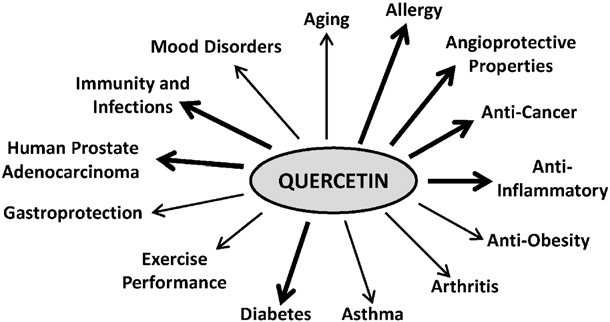
1
Quercetin as a Promising Antiviral Treatment Option
Quercetin has been demonstrated to contain antiviral properties in a variety of studies. In 2007, the U.S. Department of Defense found that quercetin lowers the risk for viral illness following extreme physical stress, which might otherwise undermine your immune function and render you more susceptible to infections.[2] Quercetin was also found to exhibit antiviral activity against vesicular stomatitis virus by activation of host defense mechanisms.[3]Additionally, a 2008 study funded by the U.S. Defense Advanced Research Projects Agency (DARPA), found that when animals treated with quercetin were challenged with a highly pathogenic H1N1 influenza virus, the treatment group had significantly lower morbidity and mortality than the placebo group.[4]
In another double-blind study, trained male cyclists were randomized to 1000 mg of quercetin or a placebo daily which they ingested before, during, and for 2 weeks after. They cycled for 3 hours per day at approximately 57% of maximal work capacity. Quercetin ingestion significantly reduced upper respiratory tract infections incidence in the cyclists during the 2-week period after intensified exercise compared to the placebo group.[5]
A 2004 animal study investigated quercetin’s effect on influenza using a strain of the H3N2 virus. The authors of this study found that quercetin decreased the oxidative stress that occurs during the influenza virus infection. Because quercetin restored the concentrations of many antioxidants, they proposed that it may be useful in protecting the lungs from the deleterious effects of oxygen-derived free radicals released during an influenza virus infection.”[6] By attenuating oxidative damage, quercetin also lowers the risk of secondary bacterial infections, which are actually the primary cause of influenza-related deaths. Importantly, quercetin increases mitochondrial biogenesis in skeletal muscles, which suggests part of its antiviral effects are due to enhanced mitochondrial antiviral signaling.
Interestingly, quercetin has also been shown to restore corticosteroid sensitivity in cells from patients with chronic obstructive pulmonary disease. Corticosteroid resistance is a major barrier to the effective treatment of chronic obstructive pulmonary disease (COPD). Oxidative stress from cigarette smoke and chronic inflammation is likely to induce this corticosteroid insensitivity. Quercetin was able to restore corticosteroid sensitivity and has the potential to be a novel treatment in combination with corticosteroids in COPD.[7]
Quercetin’s Potential Mechanisms of Antiviral Action
There are five main proposed mechanisms of action for quercetin’s antiviral activity:
- Inhibiting the ability of the virus to infect cells
- Inhibiting replication of already infected cells
- Reducing resistance of infected cells to treatment with antiviral medication
- Reducing virus-related hyper-responsiveness/inflammation (cytokine storm)
- Inhibiting viral production of heat shock proteins
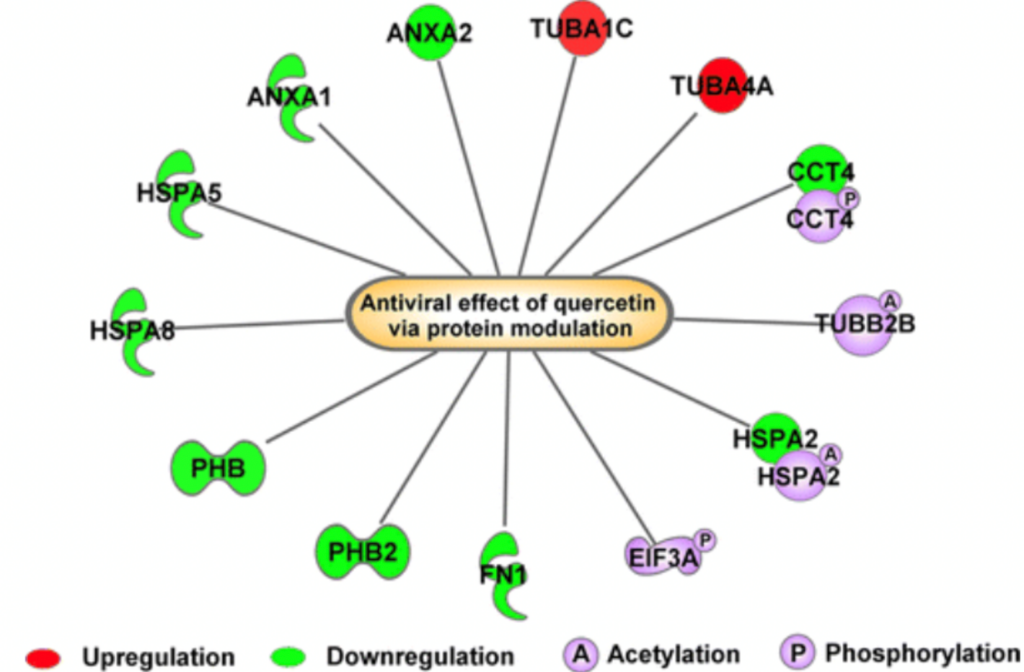
Quercetin Inhibits the Ability of the Virus to Infect Cells
One mechanism of action for quercetin’s antiviral activity is its capacity to inhibit viral infection of the cell. In 1949, quercetin was first demonstrated by Cutting et al. to prophylactically inhibit the rabies virus in mice.[8] Mitani, et al. demonstrated quercetin’s ability to inhibit infectivity and replication of the herpes simplex virus type 1, polio-virus type 1, parainfluenza virus type 3 and respiratory syncytial virus.[9] Additionally, authors of a 2016 animal study found that quercetin inhibits mouse dengue virus and hepatitis virus infection.[10] Other studies have confirmed quercetin’s inhibition of both hepatitis B12 and C13 infection. Further data suggests that quercetin may diminish the replication of the influenza virus, rhinovirus, dengue virus type-2, HSV-1, poliovirus, adenovirus, Epstein-Barr virus, Mayaro virus, Japanese encephalitis virus, respiratory syncytial virus, and HCV.[11]
In addition, several studies have confirmed quercetin’s ability to inhibit influenza infection.[12]One study published in 2016 demonstrated quercetin’s inhibition of several influenza strains, including H1N1, H3N2 and H5N1. According to the authors:
“This study indicates that quercetin shows inhibitory activity in the early stage of influenza infection and provides a future therapeutic option to develop effective, safe and affordable natural products for the treatment and prophylaxis of [influenza A viruses] infections.”[13]
Another study demonstrated the inhibition of influenza infection in a wide spectrum of strains, including two strains of H1N1 and a strain of H3N2, with only a half maximal inhibitory concentration (IC50).[14] Mechanism studies identified that quercetin shows interaction with the HA2 subunit. Moreover, quercetin could inhibit the entry of the H5N1 virus using the pseudovirus-based drug screening system. This study indicates that quercetin shows inhibitory activity in the early stage of influenza infection and provides a future therapeutic option to develop effective, safe and affordable natural products for the treatment and prophylaxis of IAV infections.[15]
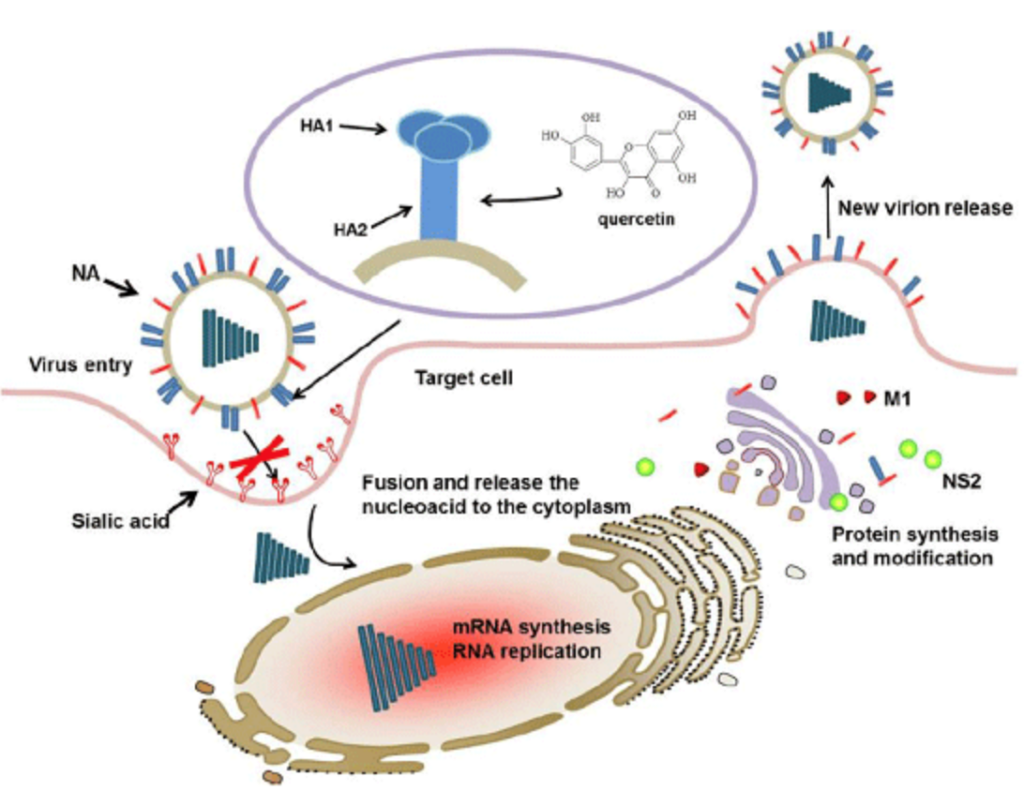
15
Quercetin has also been shown to inhibit transcription, translation and endocytosis of rhinoviruses (RV), thereby diminishing their activity. In one such study, it reduced viral infection when added 6 hours post-infection in vitro. Moreover, it also repressed interferon and interleukin-8 response, resulting in lower viral RNA and capsid protein production. Quercetin demonstrated similar effects in vivo with decreased viral loads and suppression of viral immune mediators.[16] In 2014, researchers noted that it appears to be “a promising treatment for the common cold,” caused by the rhinovirus, adding that “Quercetin has been shown to reduce viral internalization and replication in vitro, and viral load, lung inflammation and airways hyper-responsiveness in vivo.”[17]
A recent study published in March 2020 found quercetin “provides comprehensive protection against streptococcus pneumoniae infection,” both in vitro and in vivo, primarily by neutralizing pneumolysin (PLY), one of the toxins released from pneumococci that encourages S. pneumoniae infection to blossom in the first place.[18] As reported by the authors:
“The results indicate that quercetin significantly reduces PLY-induced hemolytic activity and cytotoxicity via repression of the formation of oligomers.
In addition, treatment with quercetin can reduce PLY-mediated cell injury, improve the survival rate of mice infected with a lethal dose of S. pneumoniae, alleviate the pathological damage of lung tissue and inhibit the release of cytokines (IL-1β and TNF-α) in bronchoalveolar lavage fluid. Considering the importance of these events in antimicrobial resistant S. pneumoniae pathogenesis, our results indicate that quercetin may be a novel potential drug candidate for the treatment of clinical pneumococcal infections.”
Quercetin Inhibits Replication of Already Infected Cells
Another antiviral mechanism of quercetin is its ability to inhibit replication in already infected cells. One study confirmed quercetin’s ability to reduce viral internalization and replication in vitro, as well as viral load, lung inflammation and airway hyper-responsiveness in vivo.
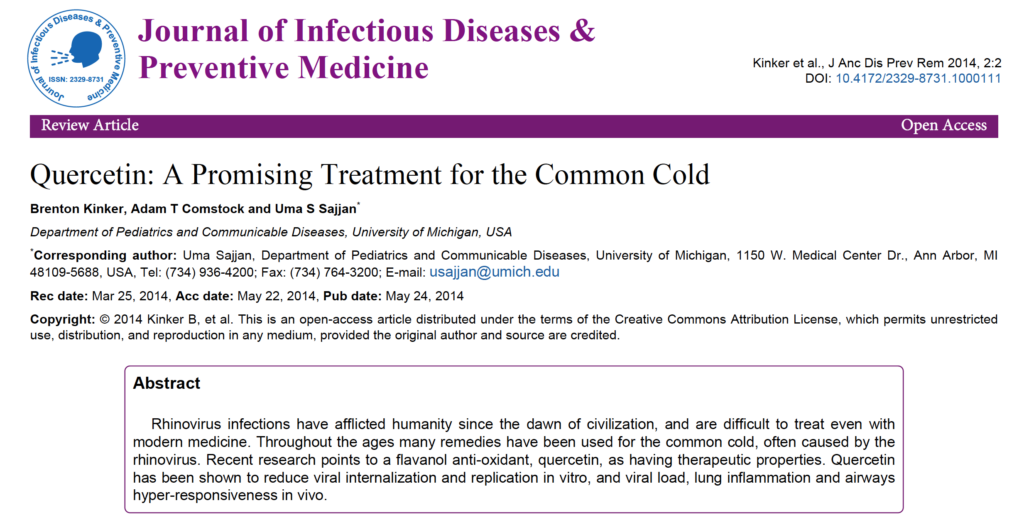
Quercetin has been shown to inhibit viral replication at various stages, and at the same time also increases viral clearance by enhancing mitochondrial antiviral responses. All these events together lead to reduced pro-inflammatory responses.19
Additionally, quercetin has been shown to inhibit severe acute respiratory-syndrome associated coronavirus (SARS-CoV) 3C-like protease (3CLpro).The 3CLpro is vital for SARS-CoV replication and is a promising drug target. This enzyme is an attractive target since it is essential for viral replication and because there are now several high-resolution X-ray structures of SARS-CoV 3CLpro available, which makes structure-based drug design possible. Quercetin, displayed good inhibition toward 3CLpro.[20]
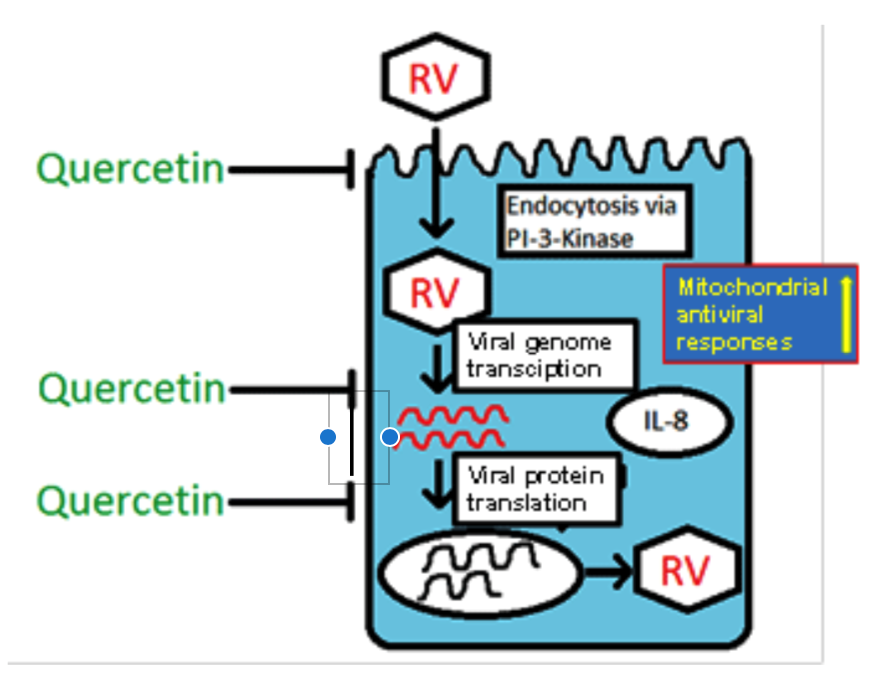
20
Quercetin Reduces Resistance of Infected Cells to Treatment with Antiviral Medication
Quercetin has also been shown to reduce resistance of infected cells to treatment with antiviral medication. In a 2010 animal study, it was found to inhibit both influenza A and B viruses. In this study, two important discoveries were made. Firstly, the viruses were unable to develop resistance to quercetin and, secondly, when used concomitant with antiviral drugs (amantadine or oseltamivir), the effect was significantly amplified — and it prevented drug-resistance from developing.[21]
Quercetin Reduces Virus Related Hyper-Responsiveness/Inflammation (Cytokine Storm)
Another antiviral mechanism of quercetin is its ability to reduce inflammation and hyperresponsiveness of the immune system. It prevents TNF-α from directly activating extracellular signal-related kinase (ERK), c-Jun NH2-terminal kinase (JNK), c-Jun, and nuclear factor-κB (NF-κB), which are potent inducers of inflammatory gene expression and protein secretion. In addition, it may indirectly prevent inflammation by increasing peroxisome proliferator-activated receptor c (PPARγ) activity, thereby antagonizing NF-κB or activator protein-1(AP-1) transcriptional activation of inflammatory genes. Together, these block TNF-α-mediated induction of inflammatory cascades.22
22
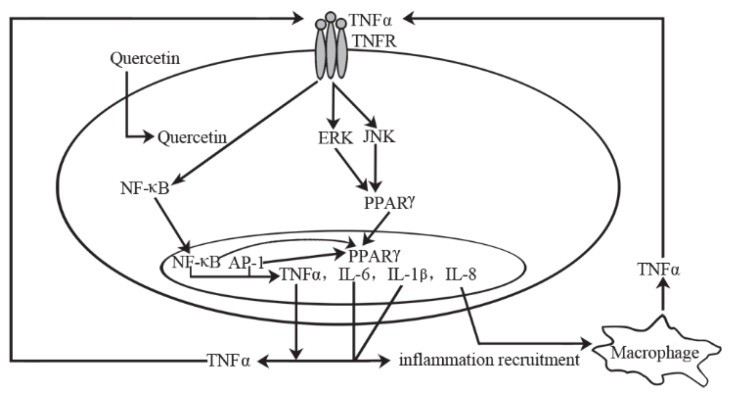
In one study, the influence of 1000 mg of quercetin with or without 120 mg of epigallocatechin 3-gallate (EGCG), 400 mg of isoquercetin, 400 mg of eicosapentaenoic acid and docosahexaenoic acid (Q-EGCG) was tested on exercise performance, muscle mitochondrial biogenesis, and changes in measures of immunity and inflammation before and after a 3-day period of heavy exertion. Two-week supplementation with Q-EGCG was effective in augmenting GOBA and in countering inflammation after 3 days of heavy exertion in trained cyclists.[22]
Quercetin Inhibits Viral Production of Heat Shock Proteins
The final mechanism of antiviral action proposed for quercetin is its potential to inhibit viral production of heat shock proteins. A 2015 study found quercetin offered protection against the influenza A virus, H1N1, by modulating heat shock protein expression. More specifically, the regulation of heat shock proteins, fibronectin 1 and prohibitin was instrumental in reducing viral replication.[23]
Quercetin May Display Greater Activity When Used in Combination with Bromelain
I prefer to combine quercetin with bromelain because the proteolytic enzymes in bromelain enhance the breakdown and absorption of quercetin. I learned this over thirty years ago from Dr. Ed Madison, the founder of and a formulator for Scientific Botanicals, a teacher of botanical medicine at Bastyr University, and one of the most brilliant minds in medicine.
Bromelain is a natural protein-digesting enzyme isolated from pineapple. Bromelain works with quercetin in two ways: First, its enzymatic activity helps your body absorb a higher percentage of the quercetin you consume; Second, it is proven to have its own anti-inflammatory properties.
A combination of oral quercetin with bromelain has shown effectiveness for chronic rhinosinusitis/sinusitis. Bromelain thins nasal secretions and has been shown to be an effective mucolytic agent in respiratory tract diseases. Bromelain promotes the inhibition of pro-inflammatory prostaglandin biosynthesis, and modulates immune response.23 Therefore, to experience the highest activity of quercetin, it may be best to use it in combination with bromelain.
References:
[1] D’Andrea, G., Quercetin: A flavonol with multifaceted therapeutic application? Fitoterapia 106 (2015) 256-271.
[2] Quercegen.com Scientific Studies, http://www.quercegen.com/science-studies.htm; retrieved April 9th, 2020.
[3] Veckenstedt, A.; Pusztai, R. Mechanism of antiviral action of quercetin against cardiovirus infection in mice. Antivir. Res. 1981, 1, 249–261
[4] Davis, JM, et. al., Quercetin reduces susceptibility to influenza infection following stressful exercise, American Journal of Physiology August 1, 2008, https://doi.org/10.1152/ajpregu.90319.2008
[5] Nieman DC, Henson DA, Gross SJ, Jenkins DP, Davis JM, Murphy EA, Carmichael MD, Dumke CL, Utter AC, McAnulty SR, McAnulty LS, Mayer EP., Quercetin reduces illness but not immune perturbations after intensive exercise. Med Sci Sports Exerc. 2007 Sep; 39(9):1561-9.
[6] Pankaj Kumar, Madhu Khanna, Vikram Srivastava, Yogesh Kumar Tyagi, Hanumanthrao G. Raj & K. Ravi (2005) EFFECT OF QUERCETIN SUPPLEMENTATION ON LUNG ANTIOXIDANTS AFTER EXPERIMENTAL INFLUENZA VIRUS INFECTION, Experimental Lung Research, 31:5, 449-459, DOI: 10.1080/019021490927088
[7] Nieman DC, Henson DA, Gross SJ, Jenkins DP, Davis JM, Murphy EA, Carmichael MD, Dumke CL, Utter AC, McAnulty SR, McAnulty LS, Mayer EP., Quercetin reduces illness but not immune perturbations after intensive exercise. Med Sci Sports Exerc. 2007 Sep; 39(9):1561-9.
[8] Cutting,W.; Dreisbach, R.; Ne, B. Antiviral chemotherapy; flavones and related compounds. Stanf. Med. Bull. 1949, 7, 137.
[9] Mitani A, Azam A, Vuppusetty C, Ito K, Mercado N, Barnes PJ. Quercetin restores corticosteroid sensitivity in cells from patients with chronic obstructive pulmonary disease. Exp Lung Res. 2017 Nov-Dec;43(9-10):417-425. doi: 10.1080/01902148.2017.1393707.
[10] Gonzalez O, Fontanes V, Raychaudhuri S, et al. The heat shock protein inhibitor Quercetin attenuates hepatitis C virus production. Hepatology. 2009;50(6):1756–1764. doi:10.1002/hep.23232
[11] Shimon Ben-Shabat SB, Antiviral effect of phytochemicals from medicinal plants: Applications and drug delivery strategies, Drug Delivery and Translational Research (2020) 10:354–367, https://doi.org/10.1007/s13346-019-00691-6
[12] Quercegen.com Scientific Studies, http://www.quercegen.com/science-studies.htm; retrieved April 9th, 2020.
[13] Chiow, KH, et. al., Evaluation of antiviral activities of Houttuynia cordata Thunb. extract, quercetin, quercetrin and cinanserin on murine coronavirus and dengue virus infection, Asian Pacific Journal of Tropical Medicine January 2016; 9(1): 1-7
[14] D’Andrea, G., Quercetin: A flavonol with multifaceted therapeutic application? Fitoterapia 106 (2015) 256-271.
[15] Wu W, Li R, Li X, et al. Quercetin as an Antiviral Agent Inhibits Influenza A Virus (IAV) Entry. Viruses. 2015;8(1):6. Published 2015 Dec 25. doi:10.3390/v8010006
[16] Keivan, Z.; Boon-Teong, T.; Sing-Sin, S.; Pooi-Fong, W.; Mustafa, M.R.; Sazaly, A. In vitro antiviral activity of fisetin, rutin and naringenin against dengue virus type-2. J. Med. Plants Res. 2011, 5, 5534–5539.
[17] Cheng, Z., Sun, G., Guo, W. et al. Inhibition of hepatitis B virus replication by quercetin in human hepatoma cell lines. Virol. Sin. 30, 261–268 (2015). https://doi.org/10.1007/s12250-015-3584-5
[18] Qianghua, LV, et. al.Quercetin, a pneumolysin inhibitor, protects mice against Streptococcus pneumoniae infection, Microbial Pathogenesis March 2020; 140: 103934
[19] Brenton Kinker, Adam T Comstock and Uma S Sajjan, Quercetin: A Promising Treatment for the Common Cold, Journal of Infectious Diseases and Preventive Medicine May 24, 2014; 2: 111
[20] Thi Thanh Hanh Nguyen, Hye-Jin Woo, Hee-Kyoung Kang, Van Dao Nguyen, Young-Min Kim, Do-Won Kim, Sul-Ah Ahn, Yongmei Xia, Doman Kim, Flavonoid-mediated inhibition of SARS coronavirus 3C-like protease expressed in Pichia pastoris, Biotechnol Lett (2012) 34:831–838 DOI 10.1007/s10529-011-0845-8
[21] Tej N. Kaul, et. al., Antiviral effect of flavonoids on human viruses, Journal of Medical Virology January 1985 DOI: 10.1002/jmv.1890150110, Antiviral Research 2010 Nov;88(2):227-35
[22] Nieman D.C., Henson D.A., Maxwell K.R., Williams A.S., McAnulty S.R., Jin F., Shanely R.A., Lines T.C. Effects of quercetin and EGCG on mitochondrial biogenesis and immunity. Med. Sci. Sports Exerc. 2009;41:1467–1475. doi: 10.1249/MSS.0b013e318199491f.
[23] Bipin Vaidya, Se-Young Cho, Kyung-Seo Oh, Song Hak Kim, Yeong O Kim, Eun-Hye Jeong, Thoa Thi Nguyen, Sung Hyun Kim, In Seon Kim, Joseph Kwon, and Duwoon Kim, Journal of Agricultural and Food Chemistry 2016 64 (21), 4416-4425, DOI: 10.1021/acs.jafc.6b00148

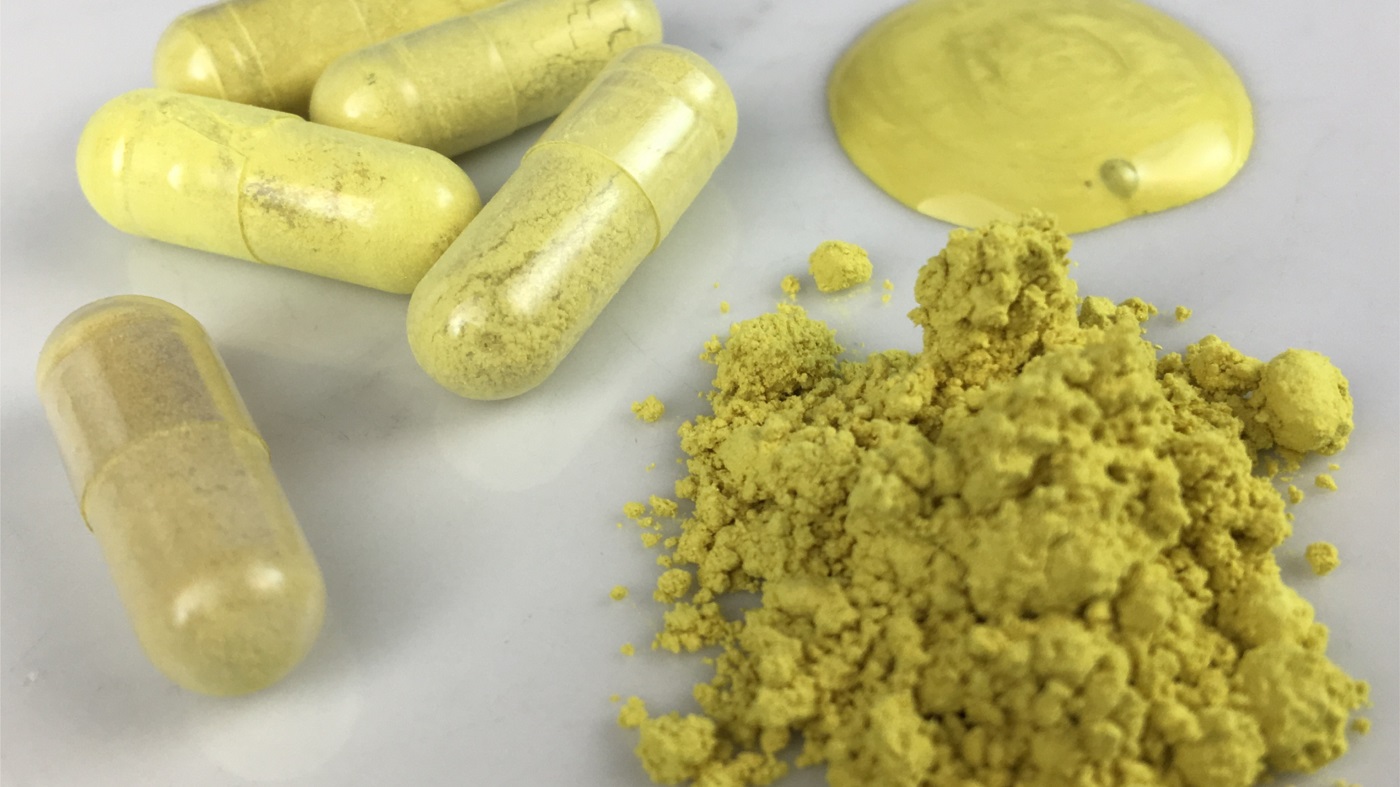
Sometimes a little info can be problematic. I have a little info about Quercetin being not so good for those with hypothyroidism. I have been on thyroid medication since a child – never do well when I go off. (On T4 + T3). Tried all sorts of natural remedies first, but no go.
So, Quercetin impact on thyroid function?
Thanks!